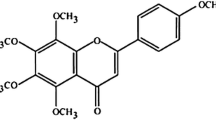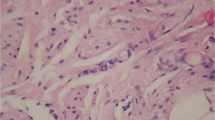Abstract
Glutathione-related enzymes belong to the protection mechanism of the cells against harmful oxidative damage and chemicals. Glutathione S-transferase (GST) is frequently over-expressed in various cancer cells and is involved in drug resistance. Chlorophyllin is an antioxidant molecule interfering with the GST P1-1 activity. The purpose of this study is to evaluate the short- and long-term protective effects of chlorophyllin as an antioxidant molecule on DNA damage, antioxidant enzyme activities, trace elements, and minerals in chemically induced breast cancer model in vivo. In our study, N-methyl-N-nitrosourea (MNU) was used for inducing breast carcinogenesis in female Sprague-Dawley rats. A total of 36 rats were divided into groups as short term and long term. Each group was divided into four sub-groups as control group received physiological saline solution (n = 3), Chl group (n = 5) received chlorophyllin, MNU group (n = 5) was administered MNU, and Chl + MNU group (n = 5) was treated with both chlorophyllin and MNU. Results illustrated that chlorophyllin had a significant anti-genotoxic effect in the short term, and glutathione-related enzyme activities were protected by chlorophyllin treatment in MNU-induced breast cancer model. Additionally, MNU administration impaired mineral and trace element levels including Na, Mg, K, Fe, Zn, and Co in the liver, kidney, spleen, heart, and tumor tissues; however, adverse effects of MNU were recovered upon chlorophyllin treatment in the indicated tissues of the rats. In conclusion, chlorophyllin can be used as an antioxidant molecule to ameliorate adverse effects of MNU by enhancing antioxidant enzyme activities and regulating trace element and mineral balance in several organs and tumor tissue in the breast cancer model.














Similar content being viewed by others
Data Availability
The datasets generated during and/or analyzed during the current study are available from the corresponding author on reasonable request.
References
Townsend DM, Tew KD (2003) The role of glutathione-S-transferase in anti-cancer drug resistance. Oncogene 22(47):7369–7375
Singh S (2015) Cytoprotective and regulatory functions of glutathione S-transferases in cancer cell proliferation and cell death. Cancer Chemother Pharmacol 75(1):1–15
Tew KD, Monks A, Barone L, Rosser D, Akerman G, Montali JA, Wheatley JB, Schmidt D (1996) Glutathione-associated enzymes in the human cell lines of the National Cancer Institute drug screening program. Mol Pharmacol 50(1):149–159
Kamiya T, Courtney M, Laukkanen MO (2016) redox-activated signal transduction pathways mediating cellular functions in inflammation, Differentiation, Degeneration, Transformation, and Death. Oxidative Medicine and Cellular Longevity 2016
Khan MA, Tania M, D-z Z, H-c C (2010) Antioxidant enzymes and cancer. Chin J Cancer Res 22(2):87–92
Aydemir D, Karabulut G, Gok M, Barlas N, Ulusu NN (2019) Data the DEHP induced changes on the trace element and mineral levels in the brain and testis tissues of rats. Data in brief 26:104526
Aydemir D, Karabulut G, Şimşek G, Gok M, Barlas N, Ulusu NN (2018) Impact of the Di (2-ethylhexyl) phthalate administration on trace element and mineral levels in relation of kidney and liver damage in rats. Biol Trace Elem Res 186(2):474–488
Aydemir D, Öztaşcı B, Barlas N, Ulusu NN (2019) Effects of butylparaben on antioxidant enzyme activities and histopathological changes in rat tissues. Arhiv za higijenu rada i toksikologiju 70(4):315–324
Gulbahce-Mutlu E, Baltaci SB, Menevse E, Mogulkoc R, Baltaci AK (2020) The effect of zinc and melatonin administration on lipid peroxidation, IL-6 levels, and element metabolism in DMBA-induced breast cancer in rats. Biological trace element research:1–8
Egner PA, Wang J-B, Zhu Y-R, Zhang B-C, Wu Y, Zhang Q-N, Qian G-S, Kuang S-Y, Gange SJ, Jacobson LP (2001) Chlorophyllin intervention reduces aflatoxin–DNA adducts in individuals at high risk for liver cancer. Proc Natl Acad Sci 98(25):14601–14606
Abdel-Latif MS, Elmeleigy KM, Aly TA, Khattab MS, Mohamed SM (2017) Pathological and biochemical evaluation of coumarin and chlorophyllin against aflatoxicosis in rat. Exp Toxicol Pathol 69(5):285–291
Devi DM, Banu N (2017) Anti-proliferative activity of chlorophyllin from Phyllanthus emblica L. against MCF-7 and Vero cell line. Research Journal of Pharmacy and Technology 10(2):516–524
Ferguson LR, Philpott M, Karunasinghe N (2004) Dietary cancer and prevention using antimutagens. Toxicology 198(1–3):147–159
Nagini S, Palitti F, Natarajan AT (2015) Chemopreventive potential of chlorophyllin: a review of the mechanisms of action and molecular targets. Nutr Cancer 67(2):203–211
Musdal Y, Hegazy UM, Aksoy Y, Mannervik B (2013) FDA-approved drugs and other compounds tested as inhibitors of human glutathione transferase P1–1. Chem Biol Interact 205(1):53–62
Esendagli G, Yilmaz G, Canpinar H, Gunel-Ozcan A, Guc M, Guc D (2009) Coexistence of different tissue tumourigenesis in an N-methyl-N-nitrosourea-induced mammary carcinoma model: a histopathological report in Sprague-Dawley rats. Lab Anim 43(1):60–64
Hsu C-Y, Chen Y-H, Chao P-Y, Chen C-M, Hsieh L-L, Hu S-P (2008) Naturally occurring chlorophyll derivatives inhibit aflatoxin B1-DNA adduct formation in hepatoma cells. Mutation Research/Genetic Toxicology and Environmental Mutagenesis 657(2):98–104
Ozcan M, Esendagli G, Musdal Y, Canpinar H, Bacanlı M, Anlar HG, Esendağlı-Yılmaz G, Beyramzadeh M, Aksoy Y (2019) Dual actions of the antioxidant chlorophyllin, a glutathione transferase P1-1 inhibitor, in tumorigenesis and tumor progression. J Cell Biochem 120(5):7045–7055
Bakare AA, Patel S, Pandey AK, Bajpayee M, Dhawan A (2012) DNA and oxidative damage induced in somatic organs and tissues of mouse by municipal sludge leachate. Toxicol Ind Health 28(7):614–623
Tice RR, Agurell E, Anderson D, Burlinson B, Hartmann A, Kobayashi H, Miyamae Y, Rojas E, Ryu JC, Sasaki Y (2000) Single cell gel/comet assay: guidelines for in vitro and in vivo genetic toxicology testing. Environ Mol Mutagen 35(3):206–221
Bacanlı M, Anlar HG, Aydın S, Çal T, Arı N, Bucurgat ÜÜ, Başaran AA, Başaran N (2017) D-limonene ameliorates diabetes and its complications in streptozotocin-induced diabetic rats. Food Chem Toxicol 110:434–442
Habig WH, Pabst MJ, Jakoby WB (1974) Glutathione S-transferases the first enzymatic step in mercapturic acid formation. J Biol Chem 249(22):7130–7139
Moron MS, Depierre JW, Mannervik B (1979) Levels of glutathione, glutathione reductase and glutathione S-transferase activities in rat lung and liver. Biochimica et biophysica acta (BBA)-general subjects 582(1):67–78
Paglia DE, Valentine WN (1967) Studies on the quantitative and qualitative characterization of erythrocyte glutathione peroxidase. J Lab Clin Med 70(1):158–169
Betke K, Brewer G, Kirkman H, Luzzato L, Motulsky A, Ramot B, Siniscalco M (1967) Standardized method for G-6-PD assay of haemolysates. WHO Tech Rep Ser 366:30–32
Aydemir D, Simsek G, Ulusu NN (2020) Dataset of the analyzing trace elements and minerals via ICP-MS: method validation for the mammalian tissue and serum samples. Data in brief 29:105218
Kinoshita Y, Yoshizawa K, Hamazaki K, Emoto Y, Yuri T, Yuki M, Kawashima H, Shikata N, Tsubura A (2016) Dietary effects of mead acid on N-methyl-N-nitrosourea-induced mammary cancers in female Sprague-Dawley rats. Biomedical reports 4(1):33–39
Faustino-Rocha AI, Ferreira R, Oliveira PA, Gama A, Ginja M (2015) N-methyl-N-nitrosourea as a mammary carcinogenic agent. Tumor Biol 36(12):9095–9117
Tsubura A, Lai Y-C, Miki H, Sasaki T, Uehara N, Yuri T, Yoshizawa K (2011) Animal models of N-methyl-N-nitrosourea-induced mammary cancer and retinal degeneration with special emphasis on therapeutic trials. In vivo 25 (1):11-22
Ceylan Ş, Harsit B, Saral O, Ozcan M, Demir I (2020) Comparison of antioxidant and antimicrobial activities of plant extracts centaury (Hypericum montbretii and Hypericum bupleuroides) and blackthorn (Paliurus spina-christi mill) in Artvin, Giresun region of Turkey. Artvin Çoruh Üniversitesi Orman Fakültesi Dergisi 21(1):13–20
Ceylan S, Harsit B, Saral O, Ozcan M, Sonmez E (2018) Investigation of antioxidant and antimicrobial activities of medicinal plants grown in the eastern black sea region of Turkey. Medical Science and Discovery 5(7):245–252
Kaur V, Kumar M, Kumar A, Kaur K, Dhillon VS, Kaur S (2018) Pharmacotherapeutic potential of phytochemicals: implications in cancer chemoprevention and future perspectives. Biomed Pharmacother 97:564–586
D’ Epiro GFR, Semprebon SC, Niwa AM, Marcarini JC, Mantovani MS (2016) Roles of chlorophyllin in cell proliferation and the expression of apoptotic and cell cycle genes in HB4a non-tumor breast cells. Toxicol Mech Methods 26(5):348–354
Kumar M, Verma V, Nagpal R, Kumar A, Behare P, Singh B, Aggarwal P (2012) Anticarcinogenic effect of probiotic fermented milk and chlorophyllin on aflatoxin-B 1-induced liver carcinogenesis in rats. Br J Nutr 107(7):1006–1016
Simonich MT, Egner PA, Roebuck BD, Orner GA, Jubert C, Pereira C, Groopman JD, Kensler TW, Dashwood RH, Williams DE (2007) Natural chlorophyll inhibits aflatoxin B 1-induced multi-organ carcinogenesis in the rat. Carcinogenesis 28(6):1294–1302
Gu X, Manautou JE (2012) Molecular mechanisms underlying chemical liver injury. Expert Rev Mol Med 14:e4
Lock EA, Reed CJ (1998) Xenobiotic metabolizing enzymes of the kidney. Toxicol Pathol 26(1):18–25
Knapen MF, Zusterzeel PL, Peters WH, Steegers EA (1999) Glutathione and glutathione-related enzymes in reproduction: a review. European Journal of Obstetrics & Gynecology and Reproductive Biology 82(2):171–184
Baltaci AK, Mogulkoc R, Baltaci SB (2019) The role of zinc in the endocrine system. Pak J Pharm Sci 32(1)
Baltaci SB, Mogulkoc R, Baltaci AK, Emsen A, Artac H (2018) The effect of zinc and melatonin supplementation on immunity parameters in breast cancer induced by DMBA in rats. Arch Physiol Biochem 124(3):247–252
da Cruz RS, de Oliveira AF, de Oca Carioni VM, Rosim MP, Miranda MLP, Fontelles CC, de Oliveira PV, Barbisan LF, Castro IA, Ong TP (2019) Dietary zinc deficiency or supplementation during gestation increases breast cancer susceptibility in adult female mice offspring following a J-shaped pattern and through distinct mechanisms. Food Chem Toxicol 134:110813
Khan S, Zafar A, Naseem I (2018) Copper-redox cycling by coumarin-di (2-picolyl) amine hybrid molecule leads to ROS-mediated DNA damage and apoptosis: a mechanism for cancer chemoprevention. Chem Biol Interact 290:64–76
Blaszczyk U, Duda-Chodak A (2013) Magnesium: its role in nutrition and carcinogenesis. Roczniki Państwowego Zakładu Higieny 64(3)
De Baaij JH, Hoenderop JG, Bindels RJ (2012) Regulation of magnesium balance: lessons learned from human genetic disease. Clinical kidney journal 5 (Suppl_1):i15-i24
Gobato RC, Chaves DFS, Chaim EA (2014) Micronutrient and physiologic parameters before and 6 months after RYGB. Surg Obes Relat Dis 10(5):944–951
Alfarouk KO, Ahmed S, Ahmed A, Elliott RL, Ibrahim ME, Ali HS, Wales CC, Nourwali I, Aljarbou AN, Bashir AH (2020) The interplay of Dysregulated pH and electrolyte imbalance in Cancer. Cancers 12(4):898
Funding
Animal studies were approved by Hacettepe University Animal Ethical Committee (approval number: 2013/72-10) before its commencement. This study was supported by Hacettepe University Scientific Research Unit (Project no: 012 D09 101 001-20) and Teaching Staff Training Program. The authors gratefully acknowledge the use of the services and facilities of the Koc University Research Center for Translational Medicine (KUTTAM), equally funded by the Republic of Turkey Ministry of Development Research Infrastructure Support Program.
Author information
Authors and Affiliations
Corresponding author
Ethics declarations
Animal studies were approved by Hacettepe University Animal Ethical Committee (approval number: 2013/72-10) before its commencement.
Disclaimer
Findings, opinions or points of view expressed in this article do not necessarily represent the official position or policies of the Ministry of Development.
Conflict of Interest
The authors declare that they have no conflict of interest.
Additional information
Publisher’s Note
Springer Nature remains neutral with regard to jurisdictional claims in published maps and institutional affiliations.
Rights and permissions
About this article
Cite this article
Ozcan, M., Aydemir, D., Bacanlı, M. et al. Protective Effects of Antioxidant Chlorophyllin in Chemically Induced Breast Cancer Model In vivo. Biol Trace Elem Res 199, 4475–4488 (2021). https://doi.org/10.1007/s12011-021-02585-6
Received:
Accepted:
Published:
Issue Date:
DOI: https://doi.org/10.1007/s12011-021-02585-6




